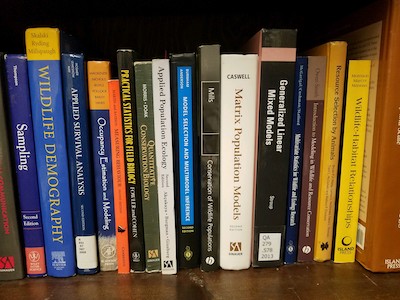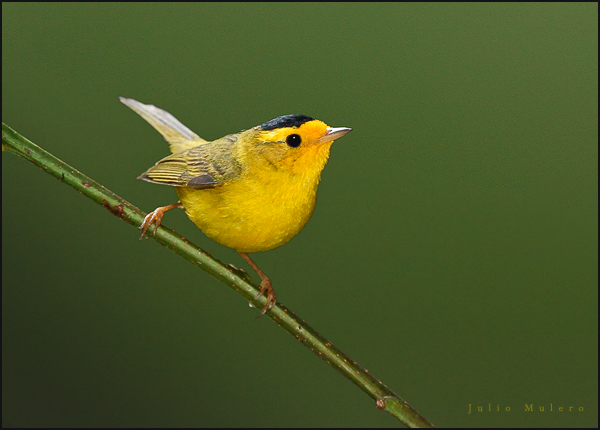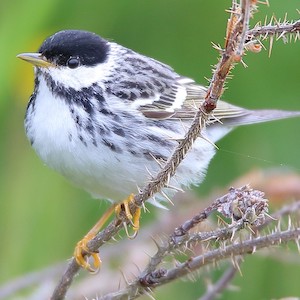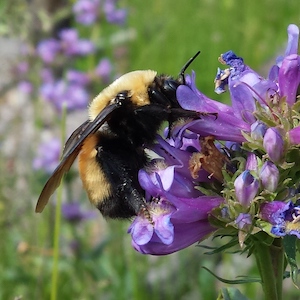You might think that scientists that study birds spend most of their time out in the fresh air using tools like binoculars and mist nets. But for many of these scientists, work "out in the field" is the highlight of their job, though not the bulk of it. These days, scientists working on bird conservation spend a lot of their time at a desk using tools like dense statistical tomes and computers with fast multi-core processors and extra RAM.

Not exactly light reading.
This sounds like a lot less fun than fieldwork, but it is just as important. Heavy duty math and powerful computers are allowing conservation scientists to answer complex but critical questions about bird populations. In a paper published this week in the journal Ecology and Evolution, IBP research ecologist Jim Saracco, along with Madeleine Rubenstein of the USGS National Climate Change & Wildlife Science Center, used gigabytes and statistical savvy to examine how climate change is affecting Wilson's Warblers- a species whose populations are declining.
The researchers combined data from 17 years of the Breeding Bird Survey (BBS) and the Monitoring Avian Productivity and Survivorship (MAPS) bird banding program. Combining these two datasets in a single analysis is no easy feat. Statistically speaking the BBS data and the MAPS data are apples and oranges, or perhaps even apples and pineapples.
The BBS is a roadside bird survey done once a year in the spring, with observers across the continent reporting counts of Wilson’s Warblers and other birds seen or heard at regular counting locations along fixed routes. The MAPS data, on the other hand, include what is called "capture-mark-recapture" data. A bird is caught, banded, released and hopefully re-caught, and the data for each individual bird consist of a series of ones and zeros denoting whether the bird was encountered at any given capture session or year.
MAPS banders collect a variety of other data on these marked birds to determine ages, which is critical information for accurately assessing demographic rates like productivity (ratios of young to adult birds) or adult survival rates. MAPS banding occurs multiple times across a summer, rather than once a year as in the BBS, and such within-season information, although time-consuming to gather, can help determine whether individuals captured are resident birds at a station or just passing through and provide a more complete picture of the status and health of the population in a given year than a single survey can.
Combining MAPS and BBS data, each collected at a unique set of sites, along with data on the climate variables of interest can prove to be quite a challenge! In the end, you've got quite the tangle of numbers to make sense of in order to find an answer to your research question.
That's where advanced statistics and computing power come in. Saracco and Rubenstein used what is called an "integrated population model" to analyze the data, something that wouldn't have been practical just a couple of decades ago. Modern, fast computers with lots of processing power allow ecologists to perform complex mathematical operations on huge sets of data, analyses that were intractable until fairly recently. Today, ecologists' tools include familiarity with math concepts like "Markov chain Monte Carlo algorithms," the ability to program a computer to run a custom analysis, and more importantly the knowledge to determine the correct statistical analysis to use in the first place. And even with modern computers, the volume of data and the complexity of the math mean a computer may need a full week to do the analysis.
So what did statistics, computers, along with the hard work of MAPS banders, BBS bird surveyors, and climate scientists tell us about Wilson's Warblers? "Our model shows that spring temperature may be important for determining breeding success for populations in the Pacific Northwest and Sierra Nevada where springs are cooler but variable year-to-year," says Saracco. This is presumably because warmer springs mean earlier snow-melt and more insects to eat and feed young. But the researchers note that there is probably a limit to this effect; theoretically springs could become too warm for insects and birds.

A Wilson's Warbler from coastal California photographed by Julio Mulero.
Saracco and Rubenstein also found that drought on the warbler's wintering grounds in northwest Mexico reduced adult survival in Sierra Nevada and coastal California populations of the species, but not in Pacific Northwest populations. Late summer is very dry in the Sierra Nevada and along the coast of California, though usually not in the Pacific Northwest. Drought at the end of the breeding season leading to fewer insects, combined with drought on the wintering grounds may be a double whammy that many individuals in these populations don't survive.
Unfortunately, droughts are expected to become more frequent as the climate changes. But targeted conservation efforts might help mitigate this. "Focusing habitat preservation efforts in Baja and northwest Mexico on areas that are both drought resilient and full of wintering Wilson's Warblers would be a good idea," says Saracco.
The researchers also looked at how spring winds might affect the warbler populations during migration as winds are known to affect survival in other migratory species. Wilson's Warblers in these populations typically face a headwind during spring migration. And while Saracco and Rubenstein did not find an effect of spring winds, they note that climate models predict that the birds will be facing stronger headwinds in the future.
Statistics and computers may not be the tools we usually associate with ornithologists and conservation biologists, but they are critical tools. With them, researchers can learn information that can help us protect the bird species we love, like when a drought in Mexico will stress warblers that breed in Yosemite. Or why migration might get harder in the future, requiring careful protection of stopover habitat along the route. A day at the desk may be less fun than a day in the field, but it's just as important.






